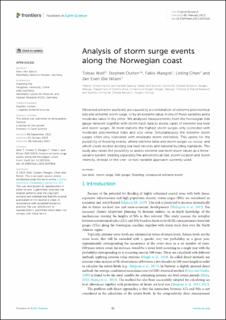| dc.contributor.author | Wolf, Tobias | |
| dc.contributor.author | Outten, Stephen | |
| dc.contributor.author | Mangini, Fabio | |
| dc.contributor.author | Chen, Linling | |
| dc.contributor.author | Nilsen, Jan Even Øie | |
| dc.date.accessioned | 2023-07-03T12:31:57Z | |
| dc.date.available | 2023-07-03T12:31:57Z | |
| dc.date.created | 2023-02-28T09:19:36Z | |
| dc.date.issued | 2023 | |
| dc.identifier.issn | 2296-6463 | |
| dc.identifier.uri | https://hdl.handle.net/11250/3075377 | |
| dc.description.abstract | Observed extreme sea levels are caused by a combination of extreme astronomical tide and extreme storm surge, or by an extreme value in one of these variables and a moderate value in the other. We analyzed measurements from the Norwegian tide gauge network together with storm track data to assess cases of extreme sea level and storm surges. At most stations the highest storm surges only coincided with moderate astronomical tides and vice versa. Simultaneously the extreme storm surges often only coincided with moderate storm intensities. This opens for the possibility of flooding events, where extreme tides and storm surges co-occur, and which could exceed existing sea level records and national building standards. This study also raises the possibility to assess extreme sea level return values as a three-variable system, treating separately the astronomical tide, storm location and storm intensity, instead of the one- or two-variable approach currently used. | en_US |
| dc.language.iso | eng | en_US |
| dc.title | Analysis of storm surge events along the Norwegian coast | en_US |
| dc.title.alternative | Analysis of storm surge events along the Norwegian coast | en_US |
| dc.type | Peer reviewed | en_US |
| dc.type | Journal article | en_US |
| dc.description.version | publishedVersion | en_US |
| dc.source.volume | 11 | en_US |
| dc.source.journal | Frontiers in Earth Science | en_US |
| dc.identifier.doi | 10.3389/feart.2023.1037826 | |
| dc.identifier.cristin | 2129944 | |
| cristin.ispublished | true | |
| cristin.fulltext | original | |
| cristin.qualitycode | 1 | |
